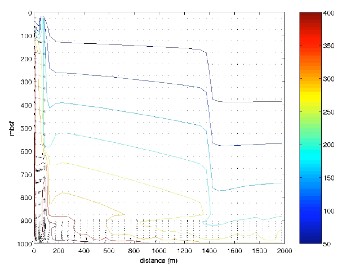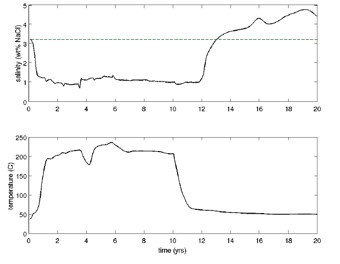Han
Numerical modeling of two-phase flow in the seafloor hydrothermal systems
L. Han¹*, R. P. Lowell¹, & K.C. Lewis²
Corresponding author: lianghan@vt.edu
¹Virginia Polytechnic and State University, Department of Geosciences, Blacksburg, Virginia, 24061
²University of Chicago, Department of Geophysical Sciences, Chicago, Illinois, 60637
Abstract:
We will present 2-D numerical simulations of seafloor hydrothermal systems using the new finite control volume numerical scheme FISHES [Lewis and Lowell, 2009a], which is capable of simulating two-phase fluid flow in the NaCl-H2O system. Our initial simulations use both single-pass and homogeneous box geometries to explore the effects of different boundary conditions and permeability distributions on the evolution of vent temperature, heat output and salinity. Coumou et al [2009] also perform the numerical simulation of phase separation, brine formation and salinity variation at Black Smoker hydrothermal systems. Although Coumou et al. [2009] solve the same governing equations, they use a different numerical scheme and a different formulation for the equation of state for NaCl-H2O. We will use FISHES to model two-phase hydrothermal circulation with a model setup as close as possible to that of Coumou et al’s [2009] in order to determine the similarities and differences between the two numerical solution schemes.
Keywords:
Numerical modeling; hydrothermal systems; phase separation; brine formation
Contributions to Integration and Synthesis:
Numerical modeling is an important method by which to understand fluid flow processes in seafloor hydrothermal systems. For these simulations to be useful, however, they must be constrained by observational data. The simulations we plan to perform are directed towards understanding the observations of heat flux together with time series data on vent temperature and salinity from the Main Endeavour Field on the Juan de Fuca Ridge. Later we plan to perform similar simulations for the Integrated Study Site on the East Pacific Rise near 950N where a full eruption cycle has been observed between 1991 and 2006. These simulations will also be coupled with simulations of magma replenishment [see abstract by Liu and Lowell at this meeting]. Seismicity data at EPR also provides information of fluid flow paths that we plan to incorporate into our models. Heat flow data at EPR is sparse and better heat flow data is needed before EPR simulations can be realistically constrained. We would like also to incorporate magma chemistry into our models. Inter comparison of the simulation output between different numerical codes using the same model setup in order to verify and improve each other will also be an important step toward model development.
References:
Lewis, K. and R. Lowell (2009a), Numerical modeling of two-phase flow in the NaCl-H2O system: Introduction of a numerical method and benchmarking, J. Geophys. Res., 114, B05202, doi: 10.1029/2008JB006029.
Coumou, D., T. Driesner, P. Weis, and C. A. Heinrich (2009), Phase separation, brine formation, and salinity variation at Black Smoker hydrothermal systems, J. Geophys. Res., 114, B03212, doi: 10.1029/2008JB005764.
Lewis, K. and R. Lowell (2009b), Numerical modeling of two-phase flow in the NaCl-H2O system: Examples, J. Geophys. Res. (in press).
Figures:
Figure 1. Isotherms (°C) for the single pass system after ten years of simulation time. [Lewis and Lowell, 2009b] Han_fig1.jpg
Figure 2. Surface vent fluid salinities (wt% NaCl) and temperatures (°C) of the single pass system for twenty years of simulation time. During the first 10 yrs of venting there is an active subsurface two-phase zone; during the next ten years subsurface temperatures have been lowered and the two-phase zone extinguished. [Lewis and Lowell, 2009b] Han_fig2.jpg


